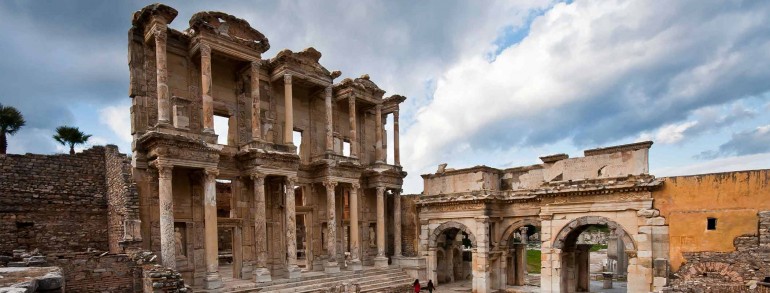Ancient writers largely agree that Ephesus was founded sometime between 1500 and 1000 B.C, and this is supported by archaeological evidence at the site. Later, it appears that Ionians settled in the cities of Ionia. According to legend, under the leadership of Androklos, son of Kodros, the migrants arrived in Anatolia, and asked their sages where their new city should be established.
The sages prophesied that a wild boar and a fish would lead them to the site of the new settlement. One day, Androklos, himself a new migrant from Greece, was cooking fish on an open fire, when a fish flew from the pan into the nearby bushes. Sparks from the fire also ignited the bushes, and as they flared up, a wild boar ran out of the bushes to escape from the flames. Androklos pursued and killed the boar. Then recalling the words of the wise men, he built his city on this site, which is at a place about 1200 metres west of the Artemision, where the original city of Ephesus was founded. The cities of Ionia were later joined together in a federation entitled the Ionian confederacy. Androklos, the city's first king, died in battle with the Carians, and the Ephesians erected a memorial to their first monarch. In the 7th century B.C, Ephesus was invaded by the Cimmerians, who razed the city to the ground, and burnt what they could, including the temple of Artemis. After this, Ephesus was ruled by a series of tyrants.
Throughout its later history, consequent to this early setback, Ephesus seemed protected from harm by the gods, and prospered either through chance or through the politics of its citizens. In the 6th century B.C, the Artemis temple was restored by the Lydian King, Croesus, who resettled the inhabitants of around the temple. But when Croesus was defeated in battle with the Persians Ephesus fell under Persian rule, along with the other cities of lonia. One of the most important features of the city was that it was an important port which served to link Sardis to Susa. The Ephesians used this factor to their own advantage in many ways. Miletus, for example, had been destroyed and burnt down during the Ionian invasion, although it had been a trade rival of Ephesus. By deciding not to support the Milesians, they both strengthened their own position, and improved trade opportunities.
Alexander the Great showed a great interest in this city as he passed through Anatolia, largely because of the significance he accorded to the temple of Artemis. After Alexander, a similar interest was shown by his commander Lysimachos, who had the city's harbour, which had already begun to silt up at that time, dredged of river silt. Thanks to his efforts, the city was able to carry on as a trading centre for some time. Lysimachos also helped to build a new Ephesus as a fortified town between Mt. Pion and Mt. Koressos. These fortifications had walls 10 metres high and covered an area 9 kms. in length. The city was further expanded by migrants who moved there from Lebedos and Colophon. It was during this period that Ephesus was adorned with a theatre, a staqium and a gymnasium.
In 88 B.C., the Ephesians allied with Mithridates, the ruler of Pontus against the Romans, and succeeded in killing thousands of Roman troops, but later began to realise the extent of the Roman strength and changed sides. This made them not only an ally of Rome, but also caused Rome to appoint Ephesus as the capital of the Asian province. Until the 1st century AD., the Ephesians enjoyed generally good relations with neighbouring states and with Rome, due to successful diplomacy. However, this did not protect them from the force of an earthquake which hit the city in 17 AD, and destroyed it completely. During the reign of the emperor Tiberius, the city was reconstructed and enlarged. Later, it was adorned with shrines and other buildings during the reign of Hadrian. The new city bore the definite seal of Roman architecture, in place of the Hellenistic city. It retained its political and mercantile supremacy during this period, and began to have religious significance during the Christian era, as it was said to have been the place of residence chosen by the mother of Christ after his crucifixion. However, the harbour began to silt up once again, and it gradually declined as a trading centre. Completely blocked with silt, the city became uninhabitable, and during the reign of the Emperor Justinian (527 -564 AD.) the inhabitants moved to the hills of Ayasoluk, where the same emperor built the basilica of St. John. The new settlement, which had been fortified, fell to the Turks in 1090.
Now let us visit the Museum of Ephesus to look at the statue of Artemis Ephesia, the altar of the Temple of Domitian, the Socrates frescos and the Theodosian reliefs from the temple of Hadrian. After studying these beautiful artefacts, we may move on to the basilica of St. John on the slopes of Ayasoluk. This magnificent basilica was built during the 6th century AD. by the emperor Justinian, and dedicated to St John. The entrance to the basilica was on the western façade, and the plan of the church was cruciform. The narthex was covered with a single cupola, and the church proper with six domes supported on columns. Under the central dome was situated the tomb of St John.
On the eastern end of the church were bays arranged in a semi-circle, used by the priests during ceremonies. The floors are mosaic, and to the north of the tomb are frescos on which are depicted several of the saints. In the centre is the figure of Christ, and to his left is that of St John and a priest The basilica has been restored several times, and on the capitals of several of the columns be seen the monograms of the Emperor Justinian and the empress Theodora. In 1869, an Englishman named Wood discovered the site of the Artemision. Excavations were carried out after this in 1904 by another Englishman named Hogarth. In 1895 the temple was first excavated by an Austrian team, and it is Austrians who are presently engaged in archeological work around the site.







